Xpeng P7+ records over 10,000 orders within 12 minutes of its launch, as Xpeng Motors rushes towards becoming an AI automaker
![]() 11/08 2024
11/08 2024
![]() 479
479
From Xpeng AI Tech Day to the Xpeng P7+ launch event, Xpeng Motors played multiple strong cards over two consecutive days.
At the "Xpeng AI Tech Day" on November 6, Xpeng Motors Chairman He Xiaopeng explained the latest progress and breakthroughs in various fields such as AI autonomous driving, flying cars, and AI robots at South China University of Technology, revealing five major black technologies: advanced autonomous driving, the "Turing" chip, flying cars, the AI operating system, and range-extending technology.
Just one day later, the Xpeng P7+ was officially launched. As a new product under the "P7" IP, the Xpeng P7+ carries Xpeng Motors' ambition to create another hit. He Xiaopeng tweeted last night that the Xpeng P7+ received over 10,000 orders within 12 minutes of its launch.
Influenced by positive news, Xpeng Motors saw significant gains in both the U.S. and Hong Kong stock markets. In the U.S. market, Xpeng Motors' share price surged by more than 15% to $14.22 per share at the close of trading on the day. In the Hong Kong market, as of the lunch break on November 8, Xpeng Motors' share price also performed strongly, increasing by more than 16% to HK$58.15 per share.
Focusing on creating hit products in the short term and striding towards the AI era over the next three years, the two-day event conveyed Xpeng Motors' determination to rush towards becoming the "best AI automaker" in the new decade.
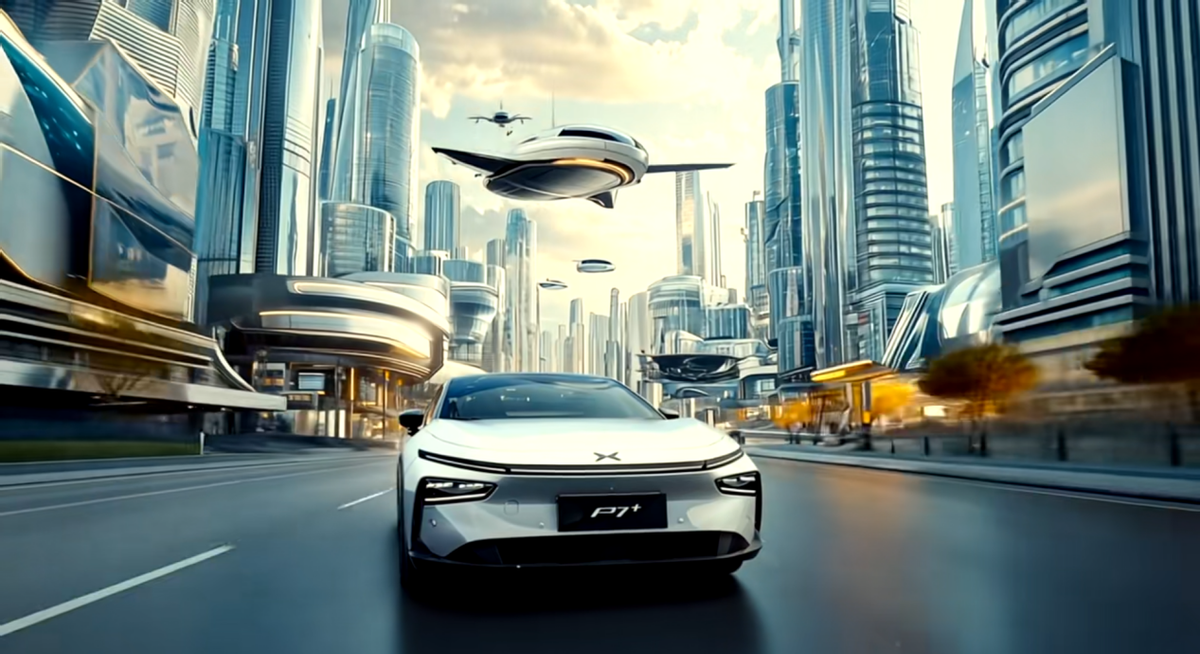
After the golden September and silver October, Xpeng Motors has climbed over the hill
This year, Xpeng Motors has changed its previous image as a "science nerd" who did not value marketing. From the high-profile launch of the Xpeng MONA M03 to the "land aircraft carrier" and then to the Xpeng P7+, it showcases a different side of Xpeng Motors.
Behind this change is the increasing sales and performance pressure on Xpeng Motors as the industry landscape has evolved in recent years.
The second half of the new energy vehicle elimination game has already begun. Data from the China Passenger Car Association shows that the penetration rate of China's new energy vehicle market has exceeded 50% per month since the second half of this year. At the same time, the rapid rise in market penetration has brought about fiercer competition. From October to the present, multiple automakers such as Xpeng, Venucia, Mercedes-Benz, and Geely have released their main models, with a total of over 40 mainstream models launched for pre-sale or market launch. The abundant supply has made it difficult for the market to escape the narrative of internal competition.
Amid industry competition, the once-leading new forces of "NIO, Xpeng, and Li Auto" have become "Li Auto, Xpeng, and NIO." The latest sales data shows that multiple automakers have set new monthly delivery records. However, as of the end of October, six out of the top ten automakers in terms of sales have achieved over 70% of their annual sales targets, while Xpeng Motors fell short of 50%, with a cumulative delivery of 122,500 new vehicles from January to October, far from its previous annual sales target of at least 280,000 vehicles for 2024.
Of course, this has also spurred Xpeng Motors' determination and action to fight to the last. When Xpeng Motors urgently needed a hit model to boost sales, the launch of the Xpeng MONA M03 signaled the arrival of Xpeng Motors' turnaround moment.
Two months after its launch, the Xpeng MONA M03 has consistently delivered over 10,000 units. Reflecting on the overall delivery data, Xpeng Motors saw a significant increase in deliveries in September and October. According to Xpeng Motors' official WeChat public account, Xpeng Motors delivered a record-high of 23,917 new vehicles in October. He Xiaopeng, Chairman and CEO of Xpeng Motors, also stated at the Xpeng P7+ launch event that the factory would increase production capacity by 30% to 40% in November and December to address delays in MONA M03 deliveries.
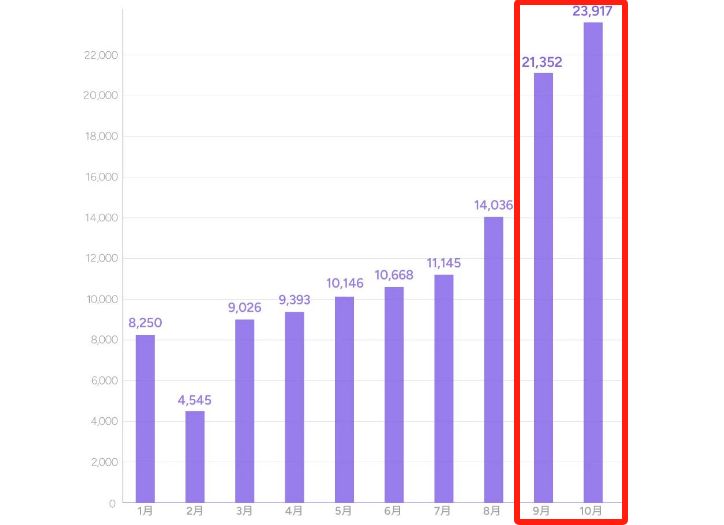
It is evident that Xpeng Motors has used the "golden September and silver October" as an inflection point, entering the eve of a favorable period. Whether it can sustain this upward momentum hinges critically on the new model, the Xpeng P7+. The Xpeng MONA M03 has taken on the task of increasing volume, focusing on cost-effectiveness. On this basis, Xpeng Motors also needs a hit model to stabilize the company's overall gross profit margin.
Judging from pre-sale data, the Xpeng P7+ has lived up to expectations. Positioned as an AI autonomous driving hatchback coupe, the official claims it is the "world's first AI car," priced starting at RMB 186,800 and delivered upon launch. Within 12 minutes of its launch, the Xpeng P7+ received over 10,000 orders.
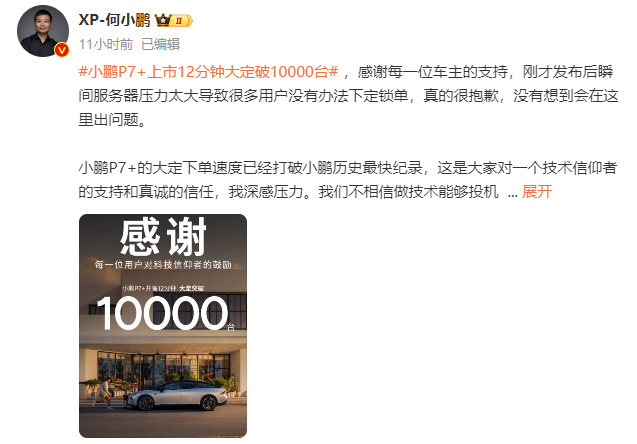
So, why is the Xpeng P7+ so popular? By consecutively launching two (pre-)hit models, what "sales code" has Xpeng Motors unlocked?
Standard end-to-end advanced autonomous driving: The groundbreaking AI car reveals Xpeng's transformation in commercialization
Summing up the selling points of the Xpeng P7+, space and autonomous driving are the two key words.
There is no need to elaborate on the spaciousness. Xpeng Motors previously used 33 20-inch suitcases to visually demonstrate how much the P7+ can "hold."
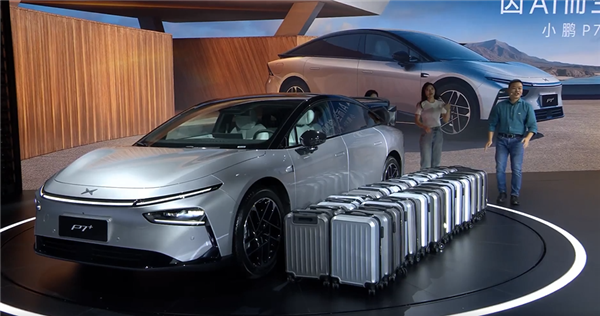
However, the more noteworthy aspect is the "end-to-end" flavor of the Xpeng P7+ in advanced intelligence. Positioned as the "world's first AI car," the Xpeng P7+ fully utilizes an end-to-end large model, implementing a pure vision solution.
Equipped with the latest AI Tianji 5.4.0, the Xpeng P7+ fully reveals Xpeng Motors' proprietary X-GPT large model and adopts an AI Eagle Eye visual driving solution, replacing LiDAR with precise mapless navigation, resulting in significant improvements in autonomous driving capabilities. For example, "human-like behavior" has increased by 4 times, lane-change success rates have increased by 53%, and detour success rates have increased by 155%. Additionally, the AI Tianji 5.4.0 system, which is launched for the first time on the Xpeng P7+, reconstructs the cabin system's architecture, integrating the powerful capabilities of a "GPT-4o"-like model into the intelligent cabin.
As a groundbreaking AI car, the Xpeng P7+ undoubtedly holds special significance.
Firstly, from a technological perspective, the Xpeng P7+ not only signifies that Xpeng Motors is accelerating the engineering implementation of new autonomous driving technologies but also showcases the company's definition of an AI car: "autonomous learning, actively meeting demands, rapid growth, and personalized experiences."
The P7+ is the first to implement an end-to-end large model "onboard," capable of active thinking and reasoning. It can also proactively predict and adjust seat positions, massage functions, and activate escort mode based on different scenario requirements, providing personalized driving experiences for users.
At the Xpeng AI Tech Day, He Xiaopeng also provided a "timeline" for the implementation of large models from the vehicle to the cloud. For example, the Xpeng vehicle-end large model aims to achieve a takeover rate of once every 100 kilometers by 2025, striving to achieve a near-L3+ autonomous driving experience within 18 months. In the future, Xpeng's advanced autonomous driving will gradually evolve towards a light map, light radar, and heavy computing power approach.
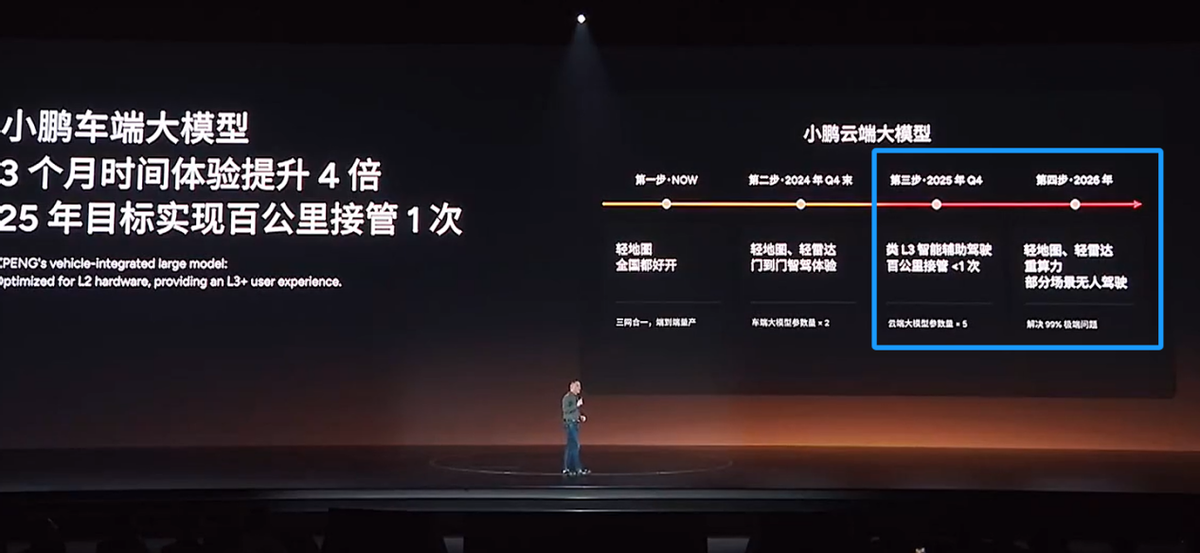
Secondly, from a commercial perspective, the Xpeng P7+ also showcases Xpeng Motors' new thinking on the autonomous driving business model to the market.
The Xpeng P7+ offers the XNGP advanced autonomous driving system as standard across all trim levels, with "no subscription, no payment required; available upon purchase of any trim level." This not only becomes a new selling point to attract car buyers but also demonstrates that the commercial implementation of advanced autonomous driving further advances the software-defined vehicle process.
Previously, He Xiaopeng stated in an interview with the media that to date, no company globally has truly profited from large models; however, autonomous driving presents an opportunity for large models to generate revenue in another dimension. "You wouldn't spend tens of thousands of dollars on a software or service, but you might readily spend over a hundred thousand yuan on a car that includes such capabilities."
In the future, by making advanced autonomous driving a standard service, Xpeng Motors is expected to unlock more value-added services, expanding its profit margins through software or ecosystem revenue.
Furthermore, the Xpeng P7+'s switch to a pure vision solution also implies continuous optimization of overall costs, which will play a crucial role in improving Xpeng Motors' long-term gross profit margin. Judging from this year's interim report, Xpeng Motors is approaching a critical juncture where profitability pierces through the cost line. With increased scale, the company's total revenue in Q2 reached RMB 8.11 billion, a year-on-year increase of 60.2%, with a further narrowed net loss of RMB 1.28 billion and a gross profit margin increased to 14%, returning to an all-time high.
In summary, it is evident that while large models are transforming autonomous driving, they are also transforming the commercial ecosystem of the automotive industry. In the next decade, AI will be the biggest game-changer in the transportation sector. If the Xpeng P7+ can sustain the pre-sale momentum, Xpeng Motors will truly enter a new phase of self-transformation and favorable development at the start of the new decade.
Navigating the red ocean of new energy vehicle manufacturing, Xpeng Motors crosses the river with its AI system
Since the second half of this year, from the MONA M03 to the P7+, Xpeng Motors has played a strong hand in the "technology research and development - commercial transformation" cycle. In He Xiaopeng's view, Xpeng Motors has only played its first card at the end of this year. Next year, from the second half of the year or even later, the cards will get better and better. From the third quarter of next year to the end of 2025, Xpeng Motors will enter a super-high-speed positive cycle.
Correspondingly, after renaming itself Xpeng AI Motors, Xpeng Motors focused on smart cars at the AI Tech Day, showcasing breakthroughs and plans in technology directions such as AI cars, AI robots, AI chips, and flying cars.
In terms of AI automotive software and hardware, Xpeng Motors unveiled its new full-stack self-developed Xpeng Turing AI autonomous driving system, encompassing "cloud - model - chip - hardware."
Specifically, firstly, a model with up to 80 times more parameters than traditional vehicle-end large models is established in the cloud, enabling reinforcement learning training in the cloud and then distilling it into the vehicle-end large model to support an XNGP near-L3 autonomous driving experience with L2 hardware.
Next are the Turing AI chip and Canghai Base developed for large models. The Turing AI chip serves as a smart "brain." Compared to general-purpose chips, the Turing AI chip not only offers computing power equivalent to three Nvidia Orin X chips but, more importantly, better meets the application requirements of vertical fields such as AI cars, flying cars, and AI robots. The Canghai Base, a neural network designed for L4 autonomous driving, can increase the vehicle's total communication bandwidth by 33 times, camera image output speed by 12 times, and achieve L4-level safety redundancy.
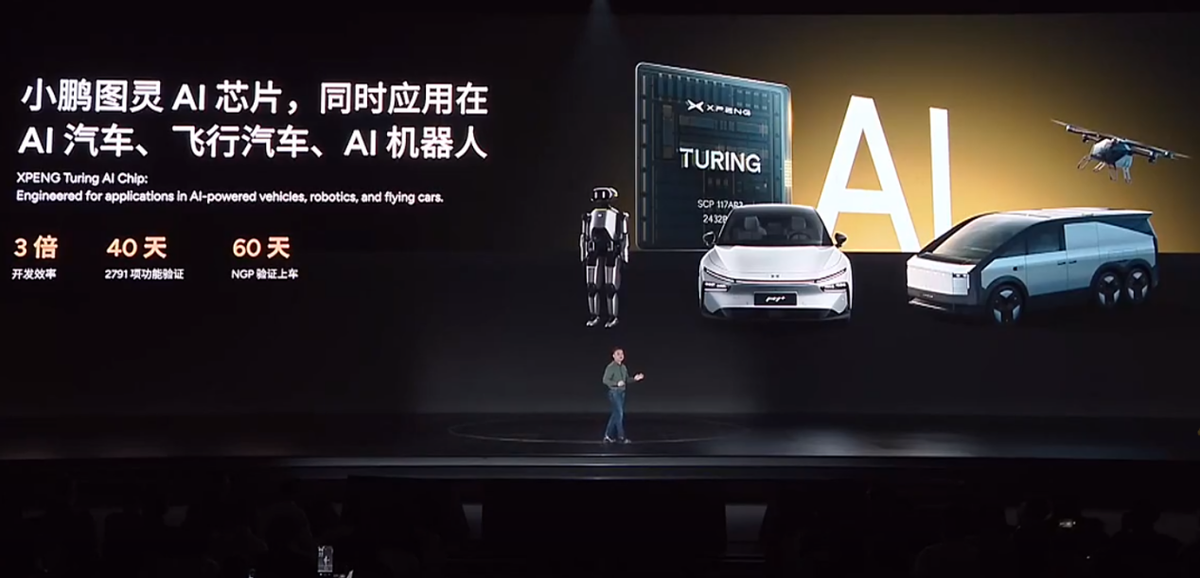
From the Xpeng Turing AI autonomous driving system, it is evident that Xpeng Motors aims to advance in both L2 and L4 technologies. Regarding this, He Xiaopeng also introduced a special system under development at Xpeng Motors, which may eliminate the steering wheel and support wire-controlled steering for advanced autonomous driving. Meanwhile, the company also plans to develop an Ultra model specifically designed for Robotaxi services.
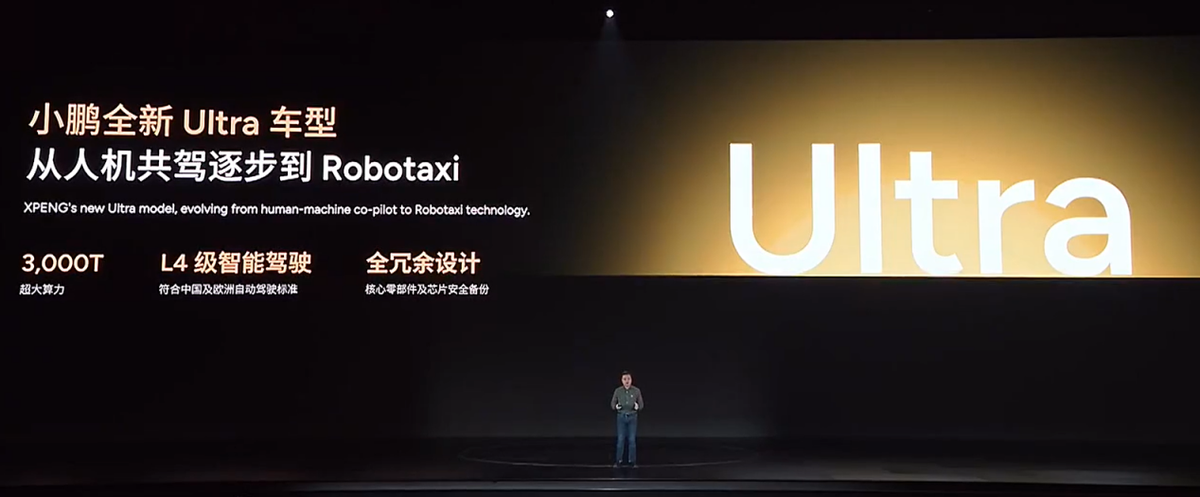
Undoubtedly, this means that after Luobo Kuaipao and Tesla popularized Robotaxi this year, the field has welcomed another heavyweight player.
In fact, after a test drive of Tesla's FSD V12 in the U.S. earlier this year, He Xiaopeng tweeted, "I believe 2025 will be the Chat GPT moment for fully autonomous driving."
As a result, Xpeng Motors accelerated the mass production of end-to-end large models for vehicles and was the first to launch the "world's first AI car" in the second half of 2024. Now, He Xiaopeng has also expressed his outlook for Robotaxi, exploring new commercialization routes.
This is not only in line with technological trends but also a necessary strategy for surviving the bloody battle in the new energy vehicle market. He Xiaopeng previously suggested that 2024-2027 will be the elimination years for Chinese automakers, with fierce competition. In the next decade, only seven mainstream Chinese automotive brands may survive, and Xpeng Motors aims to be one of them.
AI cars have always been the cornerstone of Xpeng Motors' belief in surviving this bloody battle. At the Xpeng Motors' 10th-anniversary event, He Xiaopeng predicted that in the next decade, AI will account for nearly 50% of the weight in purchasing decisions.
Therefore, Xpeng Motors aims to turn consumers' itches into pain points.
Specifically, the first approach is to accelerate the "onboarding" process of advanced autonomous driving.
The Xpeng P7+, which comes standard with advanced autonomous driving, is a new starting point. Over the next three years, Xpeng Motors will launch a large number of new and revised models.
At the same time, Xpeng Motors is no longer exclusively pursuing pure electric technology, adding an extended-range technology route. At the Tech Day, Xpeng Motors officially launched its Kunpeng Super Electric System, with "Peng" representing the pure electric system and "Kun" representing the super extended-range system. Considering the user base of extended-range new energy vehicles, the new "pure electric + extended range" model is also expected to help Xpeng Motors accelerate the popularization of AI cars.
The second approach is to reuse full-stack self-developed AI technology in fields such as flying cars and AI robots, deeply exploring more commercial increments.
He Xiaopeng previously stated that in the future, most robot companies should be automakers. Some robots are more complex than cars, while some cars are more complex than robots, but 80% of the logic is the same. The Tech Day's demonstrations also proved this point. For example, the Eagle Eye vision system on Xpeng AI cars is applied to the Xpeng AI robot Iron, enabling 720° environment perception with no blind spots. Additionally, Xpeng Motors' AI-enabled extended-range technology is also applied to the first flying car from Xpeng Huitian, which will be available for pre-sale in December.
In summary, from the various information at the AI Tech Day, it is evident that Xpeng Motors has clarified its future development path: with AI cars as the backbone, expanding into flying cars, AI robots, and other businesses to create a compounding effect of technology and open up broader long-term growth opportunities.
Conclusion
From manufacturing AI cars to flying cars, from AI autonomous driving to AI robots, Xpeng Motors has introduced many new variables. However, these variables revolve around one constant: using intelligence to change the "origin" of urban transportation.
So, can Xpeng Motors become the "best AI automaker" in the next decade? This story that began with intelligence continues...
Source: Hong Kong Stocks Research Society






